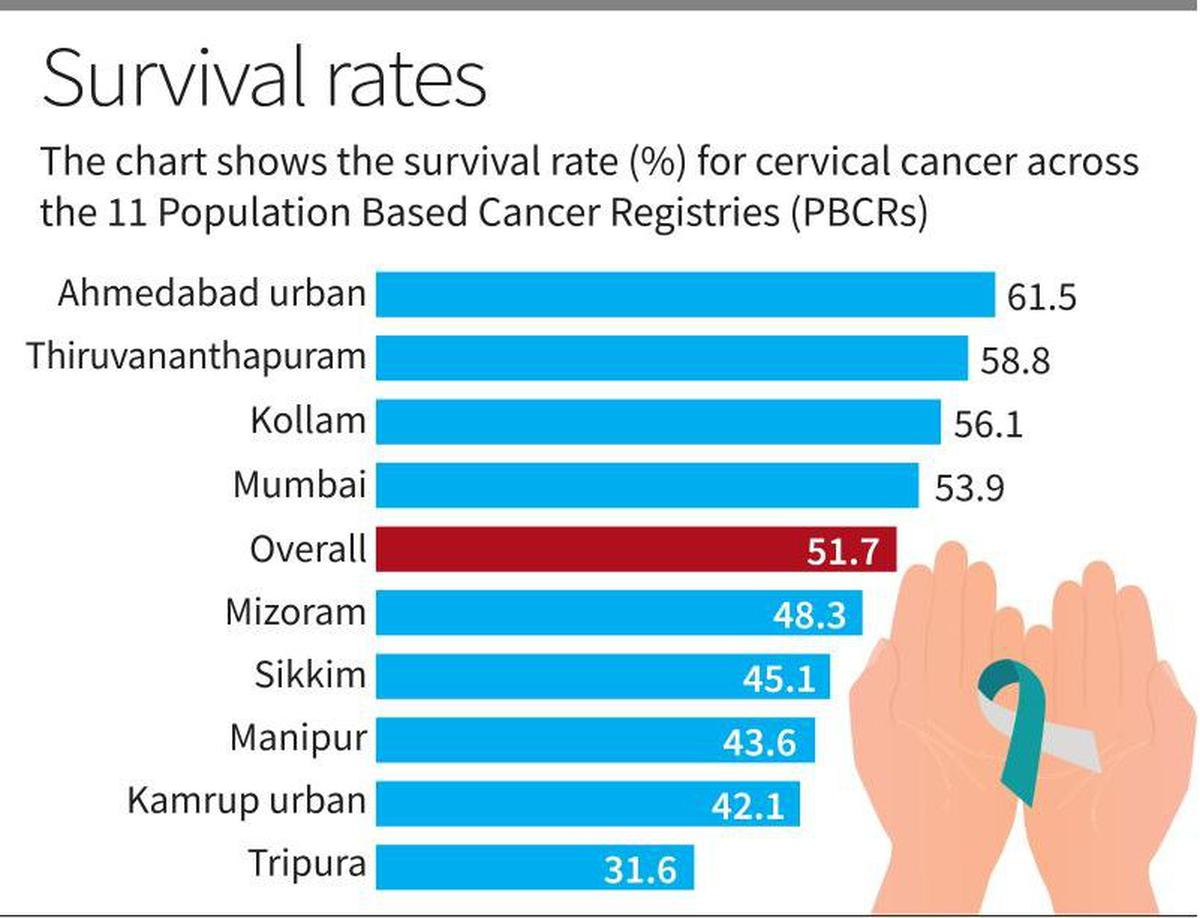Social Justice
Cancer Cases and Cure in India
- 23 Oct 2023
- 7 min read
For Prelims: Cervical Cancer, Population Based Cancer Registries (PBCRs), The Lancet, National Centre for Disease Informatics and Research, Indian Council of Medical Research (ICMR)
For Mains: Rising Cases of Different forms of Cancer in India and its impact on Health Sector
Why in News?
A recent study published in The Lancet Regional Health Southeast Asia has revealed that there is a significant regional disparity in the survival rates of cervical cancer patients across India.
What Were the Key Findings Of the Study?
- Survival rate:
- About 52% of cervical cancer cases diagnosed between 2012 and 2015 survived.
- Variations Across Regions:
- Among those that participated in the study, the Ahmedabad urban registry demonstrated the highest survival rate at 61.5%, followed by Thiruvananthapuram with 58.8% and Kollam at 56.1%. In contrast, Tripura reported a survival rate of 31.6%.
- Factors Contributing to Regional Disparities:
- The study noted that factors such as access to diagnostic services, effective treatment, distance from clinical care facilities, travel costs, co-morbidities, and poverty contributed to survival rates.
Cervical Cancer
- Cervical cancer develops in a woman's cervix (the entrance to the uterus from the vagina).
- Almost all cervical cancer cases (99%) are linked to infection with high-risk human papillomaviruses (HPV), an extremely common virus transmitted through sexual contact.
- Two HPV types (16 and 18) are responsible for nearly 50% of high grade cervical pre-cancers.
- Cervical cancer is the fourth most common cancer among women globally. About 90% of the new cases and deaths worldwide in 2020 occurred in low- and middle-income countries.
- Comprehensive cervical cancer control includes primary prevention (vaccination against HPV), secondary prevention (screening and treatment of pre-cancerous lesions), tertiary prevention (diagnosis and treatment of invasive cervical cancer) and palliative care.
What are Some of the Challenges Faced by Healthcare Providers in Curing Cancer?
- Heterogeneity of Cancer: Cancer is not a single disease but a group of diseases characterized by the uncontrolled division and growth of abnormal cells. The heterogeneity of cancer makes it challenging to find a universal cure, as each type may require a different approach.
- Late Diagnosis: Many cancer cases are diagnosed at an advanced stage, reducing the chances of a complete cure. Early detection methods and public awareness are crucial but often lacking in many regions.
- Treatment Toxicity: Traditional cancer treatments, such as chemotherapy and radiation therapy, can have severe side effects, affecting a patient's quality of life. Developing targeted therapies with fewer side effects is a challenge.
- Resistance to Treatment: Some cancers develop resistance to treatment over time, making it harder to cure. Developing strategies to overcome resistance is a key challenge.
- Cost of Treatment: Cancer treatment can be prohibitively expensive, and not all patients can afford it. The high cost of cancer drugs and therapies is a significant barrier to curing cancer.
- Lack of Access to Care: In many regions, especially in low-income countries, there is a lack of access to cancer care facilities and specialists. This contributes to regional disparities in cancer outcomes.
- Apart from this, lack of awareness among patients about their rights and obligations under the law and schemes and inadequate training and capacity building for healthcare providers aggravate the issue.
- Limited Availability of Specialized Care: Specialized cancer care centers, equipped with the latest technology and skilled healthcare professionals, are concentrated in urban areas, leaving rural and remote areas underserved.
- Stigmatization and Fear: Cultural and social stigmatization can lead to delayed diagnosis and treatment, as patients may avoid seeking help due to fear, shame, or misinformation.
What are the Different Ways to Reduce Regional Disparities in Cancer Care in India?
- Awareness and Education: Launch public awareness campaigns about cancer prevention, early detection, and available treatments. These campaigns should be tailored to different regions and languages.
- Preventive Measures: Promote healthy lifestyles, discourage tobacco use, and emphasize the importance of regular screenings and vaccinations (e.g., HPV vaccine for cervical cancer prevention).
- Primary Healthcare Strengthening: Improve the quality and accessibility of primary healthcare in underserved regions. Develop a network of primary healthcare centers that can identify and refer to potential cancer cases.
- Telemedicine: Use telemedicine and mobile health units to provide cancer consultations and education to remote areas. This can help patients access expert opinions and guidance.
- Government Initiatives: Implement and fund government-sponsored cancer care initiatives, such as the National Cancer Control Program. Allocate resources to build and upgrade cancer treatment centers in underserved regions.
- Subsidized Treatment: Provide subsidies for cancer treatment, especially for economically disadvantaged patients, through government schemes and insurance programs.
- Research and Development: Invest in cancer research and innovation to develop cost-effective treatments and diagnostics. Encourage partnerships between government, academia, and the private sector.
- Community Engagement: Involve local communities and NGOs in awareness campaigns and support services. This can help in breaking down cultural stigmas and improving access to care.
What are the Government Initiatives Related to Cancer Treatment?
UPSC Civil Services Examination, Previous Year Questions (PYQs)
Q 1. Consider the following statements: (2010)
- The Taxus tree is naturally found in the Himalayas.
- The Taxus tree is listed in the Red Data Book.
- A drug called “taxol” is obtained from Taxus trees and is effective against Parkinson’s disease.
Which of the statements given above is/are correct?
(a) 1 only
(b) 1 and 2 only
(c) 2 and 3 only
(d) 1, 2 and 3
Ans: (b)







